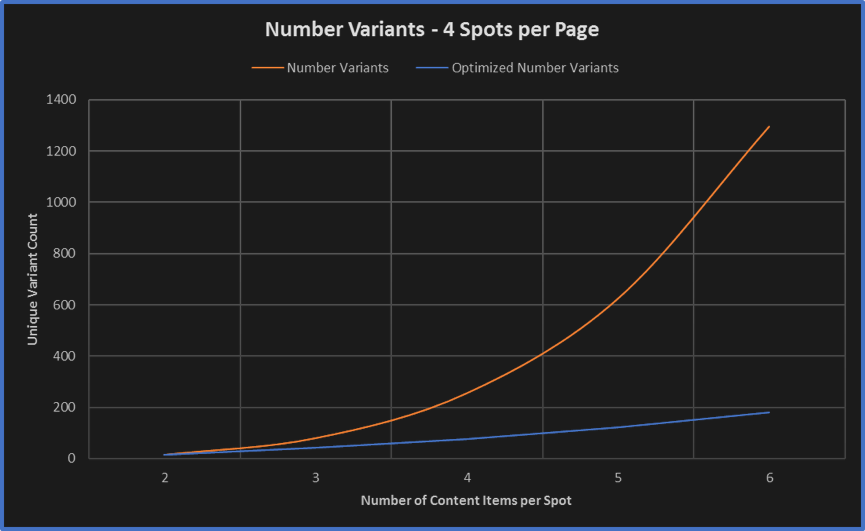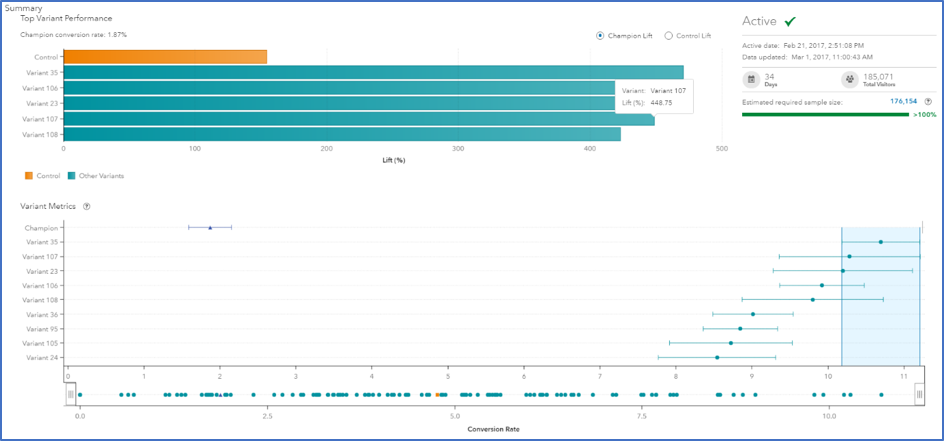 Multivariate testing (MVT) is another “decision helper” in SAS® Customer Intelligence 360 that is geared at empowering digital marketers to be smarter in their daily job. MVT is the way to go when you want to understand how multiple different web page elements interact with each other to influence goal conversion rate. A web page is a complex assortment of content and it is intuitive to expect that the whole is greater than the sum of the parts. So, why is MVT less prominent in the web marketer’s toolkit?
Multivariate testing (MVT) is another “decision helper” in SAS® Customer Intelligence 360 that is geared at empowering digital marketers to be smarter in their daily job. MVT is the way to go when you want to understand how multiple different web page elements interact with each other to influence goal conversion rate. A web page is a complex assortment of content and it is intuitive to expect that the whole is greater than the sum of the parts. So, why is MVT less prominent in the web marketer’s toolkit?
One major reason – cost. In terms of traffic and opportunity cost, there is a combinatoric explosion in unique versions of a page as the number of elements and their associated levels increases. For example, a page with four content spots, each of which have four possible creatives, leads to a total of 256 distinct versions of that page to test.
If you want to be confident in the test results, then you need each combination, or variant, to be shown to a reasonable sample size of visitors. In this case, assume this to be 10,000 visitors per variant, leading to 2.5 million visitors for the entire test. That might take 100 or more days on a reasonably busy site. But by that time, not only will the web marketer have lost interest – the test results will likely be irrelevant.
A/B testing: The current standard
Today, for expedience, web marketers often choose simpler, sequential A/B tests. Because an A/B test can only tell you about the impact of one element and its variations, it is a matter of intuition when deciding which elements to start with when running sequential tests.
Running a good A/B test requires consideration of any confounding factors that could bias the results. For example, someone changing another page element during a set of sequential A/B tests can invalidate the results. Changing the underlying conditions can also reduce reliability of one or more of the tests.
The SAS Customer Intelligence 360 approach
The approach SAS has developed is the opposite of this. First, you run an MVT across a set of spots on a page. Each spot has two or more candidate creatives available. Then you look to identify a small number of variants with good performance. These are then used for a subsequent A/B test to determine the true winner. The advantage is that underlying factors are better accounted for and, most importantly, interaction effects are measured.
But, of course, the combinatoric challenge is still there. This is not a new problem – experimental design has a history going back more than 100 years – and various methods were developed to overcome it. Among these, Taguchi designs are the best known. There are others as well, and most of these have strict requirements on the type of design. safety consideration.
SAS Customer Intelligence 360 provides a business-user interface which allows the marketing user to:
- Set up a multivariate test.
- Define exclusion and inclusion rules for specific variants.
- Optimize the design.
- Place it into production.
- Examine the results and take action.
The analytic heavy lifting is done behind the scenes, and the marketer only needs to make choices for business relevant parameters.
MVT made easy
The immediate benefit is that that multivariate tests are now feasible. The chart below illustrates the reduction in sample size for a test on a page with four spots. The red line shows the number of variants required for a conventional test, and how this increase exponentially with the number of content items per spot.
In contrast, the blue line shows the number of variants required for the optimized version of the test. Even with three content items per spot, there is a 50 percent reduction in the number of unique variants, and this percentage grows larger as the number of items increase. We can translate these numbers into test duration by making reasonable assumptions about the required sample size per variant (10,000 visitors) and about the traffic volume for that page (50,000 visitors per day). The result is shown below.
A test that would have taken 50 days will only take18 days using SAS’ optimized multivariate testing feature. More impressively, a test that would take 120 days to complete can be completed in 25 days.
What about those missing variants?
If only a subset of the combinations are being shown, how can the marketer understand what would happen for an untested variant? Simple. SAS Customer Intelligence 360 fits a model using the results for the tested variants and uses this to predict the outcomes for untested combinations. You can simulate the entire multivariate test and draw reliable conclusions in the process.
The Top Variant Performance report in the upper half of the results summary above indicates the lift for the best-performing variants relative to a champion variant (usually the business-as-usual version of the page). The lower half of the results summary (Variant Metrics) represents each variant as a point located according to a measured or predicted conversion rate. Each point also has a confidence interval associated with the measurement. In the above example, it’s easy to see that there is no clear winner for this test. In fact, the top five variants cannot reliably be separated. In this case, the marketer can use the results from this multi-variate test to automatically set up an A/B test. Unlike the A/B-first approach, narrowing down the field using an optimized multivariate test hones in on the best candidates while accounting for interaction effects.
Making MVT your go-to option
Until now, multivariate testing has been limited to small experiments for all but the busiest websites. SAS Customer Intelligence 360 brings the power of multi-variate testing to more users, without requiring them to have intimate knowledge of design of experiment theory. While multivariate testing will always require larger sample sizes than simple A/B testing, the capabilities presented here show how many more practical use cases can be addressed.



